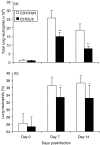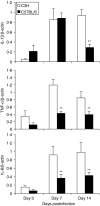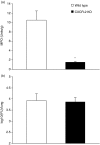Intranasal inoculation of Chlamydia trachomatis mouse pneumonitis agent induces significant neutrophil infiltration which is not efficient in controlling the infection in mice
- PMID: 15667569
- PMCID: PMC1782079
- DOI: 10.1111/j.1365-2567.2004.02088.x
Intranasal inoculation of Chlamydia trachomatis mouse pneumonitis agent induces significant neutrophil infiltration which is not efficient in controlling the infection in mice
Abstract
Previous studies have shown that chlamydial infection is accompanied by significant infiltration of neutrophils at the site of infection. However, the role of neutrophils in host defence against chlamydial infection is not clearly understood. Using genetically different inbred mouse strains and CXCR-2 gene knockout (KO) mice, we examined the mechanism for neutrophil recruitment and the role of neutrophils during chlamydial lung infection. Our data showed that C3H mice exhibited significantly higher and more persistent neutrophil infiltration in the lung than did C57BL/6 mice following Chlamydia trachomatis mouse pneumonitis infection. The massive neutrophil infiltration in C3H mice was paralleled by high-level expression of CXCR-2 and its ligands, CXC chemokines (macrophage inflammatory protein 2, cytokine-induced neutrophil attractant (KC) and lipopolysaccharide-induced CXC chemokine), and proinflammatory cytokines (tumour necrosis factor-alpha, interleukin-1 and interleukin-6) in the lung. Although much greater infiltration of neutrophils was observed in C3H mice than in C57BL/6 mice, the former mice had more severe disease and higher in vivo chlamydial growth than the latter. Moreover, CXCR-2 KO mice, which revealed a dramatic reduction in neutrophil activity, showed comparable chlamydial infection to wild-type mice. These results suggest that neutrophils are not efficient for controlling chlamydial lung infection.
Figures







References
-
- Perry LL, Feilzer K, Caldwell HD. Immunity to Chlamydia trachomatis is mediated by T helper 1 cells through IFN-gamma-dependent and -independent pathways. J Immunol. 1997;158:3344–52. - PubMed
-
- Yang X. Role of cytokines in Chlamydia trachomatis protective immunity and immunopathology. Curr Pharm Des. 2003;9:67–73. - PubMed
Publication types
MeSH terms
Substances
LinkOut - more resources
Full Text Sources
Medical
Research Materials

